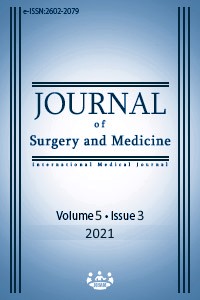Retrospective cohort study of pregnancy terminations before the 24th week of pregnancy
Keywords:
termination of pregnancy, congenital malformations, foetal indicationsAbstract
Background/Aim: Termination, which indicates ending the pregnancy process, should be performed in fetal anomalies incompatible with life or maternal-life threatening pregnancies. Pregnancy termination involves a challenging process for both the clinician and the patients. Identifying the pathology indicating termination and sharing this decision with the family should include certain strategies. In this study, the indications for termination decision were examined. We think that these indications may help the clinician make a termination decision. Methods: In this retrospective cohort study, the indications, and termination procedures performed on 707 pregnant women in the Perinatology clinic of Izmir Tepecik Training and Research Hospital between November 2016 and November 2020 were analyzed retrospectively. Results: The total number of patients who underwent termination was 707. Their ages varied between 14 and 45 years (median 29.6). The median number of pregnancies among all patients was 2.5 (range: 1-12). The minimum and maximum gestational weeks of termination were 10 and 24 weeks, respectively (median 17.4). Termination indications were divided into groups: a) Congenital malformations (without karyotype diagnosis) (n=400, 56.5%) b) Congenital malformation with diagnosed karyotype anomalies (n=27, 3.8%) c) Only karyotype anomalies (n=146, 20.6%) d) Other fetal / obstetric disorders (anhydramnios, Preterm Premature Rupture of Membranes (PPROM), teratoma, Twin-to-twin transfusion syndrome (TTTS), drug use (n=115, 16.2%) e) Maternal causes (n=19, 2.6%). In addition, each group was divided into three groups according to the weeks of termination as 11-14 weeks, 15-22 weeks, and 23-24 weeks. The total number of patients for these groups were 170, 503 and 34, respectively. Patients without fetuses with karyotype anomalies and who were terminated due to congenital malformations were grouped according to the origin of the malformation: a) Central nervous system anomalies (57.2%) b) Multiple anomalies (18.7%) c) Hydrops fetalis (8%) d) Urinary system anomalies (6.5%) e) Skeletal system anomalies (5.7%) f) Cardiac anomalies (1.7%) g) Conjoined twins (1%) h) Congenital pulmonary airway obstruction (0.5%) i) Congenital diaphragmatic hernia (0.2%). Conclusion: The continuation of abnormal pregnancies brings many problems. Termination of pregnancies that are incompatible with life or involving serious anomalies is necessary in most cases. In daily practice, making the decision of termination and sharing it with the family should include an important algorithm.
Downloads
References
Republic of Turkey Official Newspaper. 18/12/1983, number:18255/3. Law on population planning no:2827
Edwards L, Hui L. First and second trimester screening for fetal structural anomalies. Semin Fetal Neonatal Med. 2018;23(2):102-11. doi: 10.1016/j.siny.2017.11.005.
Werner H, Marcondes M, Daltro P, Fazecas T, Ribeiro G. Three-dimensional reconstruction of fetal abnormalities using ultrasonography and magnetic resonance imaging. J Matern Fetal Neonatal Med. 2019;32(20):3502-8. doi: 10.1080/14767058.2018.1465558
Mervak BM, Altun E, McGinty KA, Hyslop WB, Semelka RC, Burke LM. MRI in pregnancy: Indications and practical considerations. J Magn Reson Imaging. 2019;49(3):621-31. doi: 10.1002/jmri.26317.
Milliez J. Ethical aspects concerning termination of pregnancy following prenatal diagnosis. FIGO Committee for the Ethical Aspects of Human Reproduction and Women’s Health. Int J Gynaecol Obstet. 2008;102(1):97-8. doi: 10.1016/j.ijgo.2008.03.002
Aslan H, Yildirim G, Ongut C, Ceylan Y. Termination of pregnancy for fetal anomaly. Int J Gynecol Obstet. 2007; 99(3):221–4. doi: 10.1016/j.ijgo.2007.05.047
Ozyuncu O, Orgul G, Tanacan A, Aktoz F, Guleray N, Fadiloglu E, et al. Retrospective analysis of indications for termination of pregnancy. J Obstet Gynaecol. 2018;39(3):355–8. doi: 10.1080/01443615.2018.1506427
Celep G, Ogur G, Günal N, Baysal K. DiGeorge syndrome (Chromosome 22q11.2 deletion syndrome): A historical perspective with review of 66 patients. J Surg Med. 2019;3(1):58-63. doi: 10.28982/josam.513859
Salvador J, Arigita M, Carreras E, Borrel A. Evolution of prenatal detection of neural tube defects in the pregnant population of the city of Barcelona from 1992 to 2006. Prenat Diagn. 2011;31(10):1184–8. doi:10.1002/pd.2863
Hamida EB, Ayadi I, Bezzine A, Rabii B, Hammouda SB, Bouguerra B, et al. Termination of pregnancy for fetal anomaly in a Tunisian population. S Afr J Obstet Gynaecol. 2017;23(2):69–70. doi: 10.7196/SAJOG.2017.v23i2.1159
Samadirad B, Khamnian Z, Hosseini MB, Dastgiri S. Congenital anomalies and termination of pregnancy in Iran. J Pregnancy. 2012;2012:574513. doi: 10.1155/2012/574513
Domröse CM, Bremer S, Buczek C, Geipel A, Berg C, Hellmund A, et al. Termination of pregnancy following prenatally diagnosed central nervous system malformations. Arch of Gynecol Obstet. 2018;298(5):903–10. doi: 10.1007/s00404-018-4900-8.
Hobbs CA, Cleves MA, Simmons CJ. Genetic Epidemiology and Congenital Malformations. Arch Pediatr Adolesc Med. 2002;156(4):315. doi: 10.1001/archpedi.156.4.315
Dai R, Yu Y, Xi Q, Hu X, Zhu H, Liu R, et al. Prenatal diagnosis of 4953 pregnant women with indications for genetic amniocentesis in Northeast China. Mol Cytogenet. 2019;12(1):1–7. doi: 10.1186/s13039-019-0457-x.
Sun Y, Zhang P, Zhang N, Rong L, Yu X, Huang X, et al. Cytogenetic analysis of 3387 umbilical cord blood in pregnant women at high risk for chromosomal abnormalities. Mol Cytogenet. 2020;13(1):1–6. doi: 10.1186/s13039-020-04696
Tayeh G, Jouannic JM, Mansour F, Kesrouani A, Attieh E. Complexity of consenting for medical termination of pregnancy: Prospective and longitudinal study in Paris. BMC Med Ethics. 2018;19(1):1–7. doi: 10.1186/s12910-018-0270-9
Govender L, Ndjapa C, Aldous C, Moodley J. A pilot study of women’s experiences after being offered late termination of pregnancy for severe fetal anomaly. Niger J Clin Pract. 2015;18(7):S71–6. doi: 10.4103/1119-3077.170825
Downloads
- 465 574
Published
Issue
Section
How to Cite
License
Copyright (c) 2021 İbrahim Ömeroğlu, Barış Sever, Hakan Gölbaşı, Zübeyde Çakır, Mehmet Özer, Alkım Yıldırım
This work is licensed under a Creative Commons Attribution-NonCommercial-NoDerivatives 4.0 International License.
















